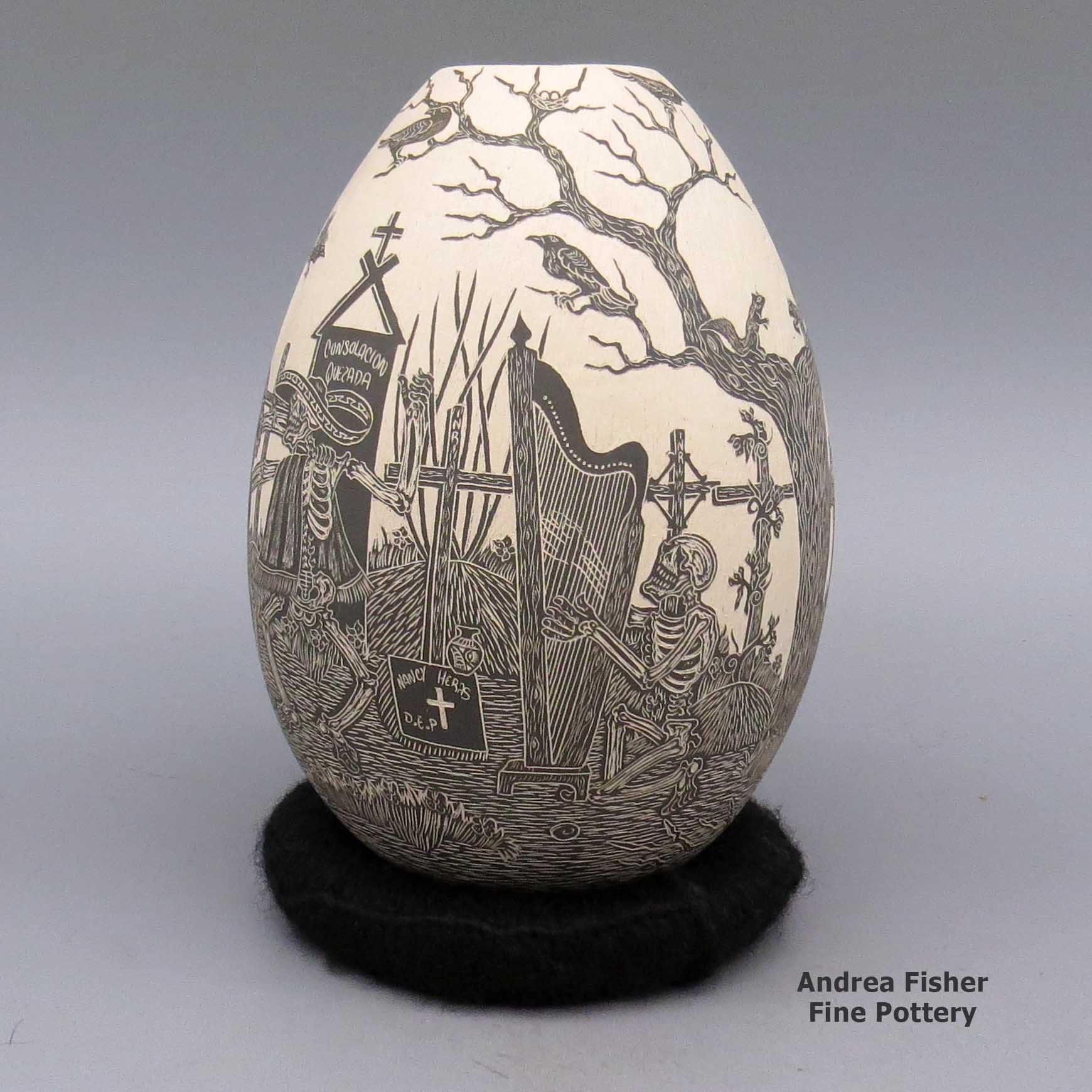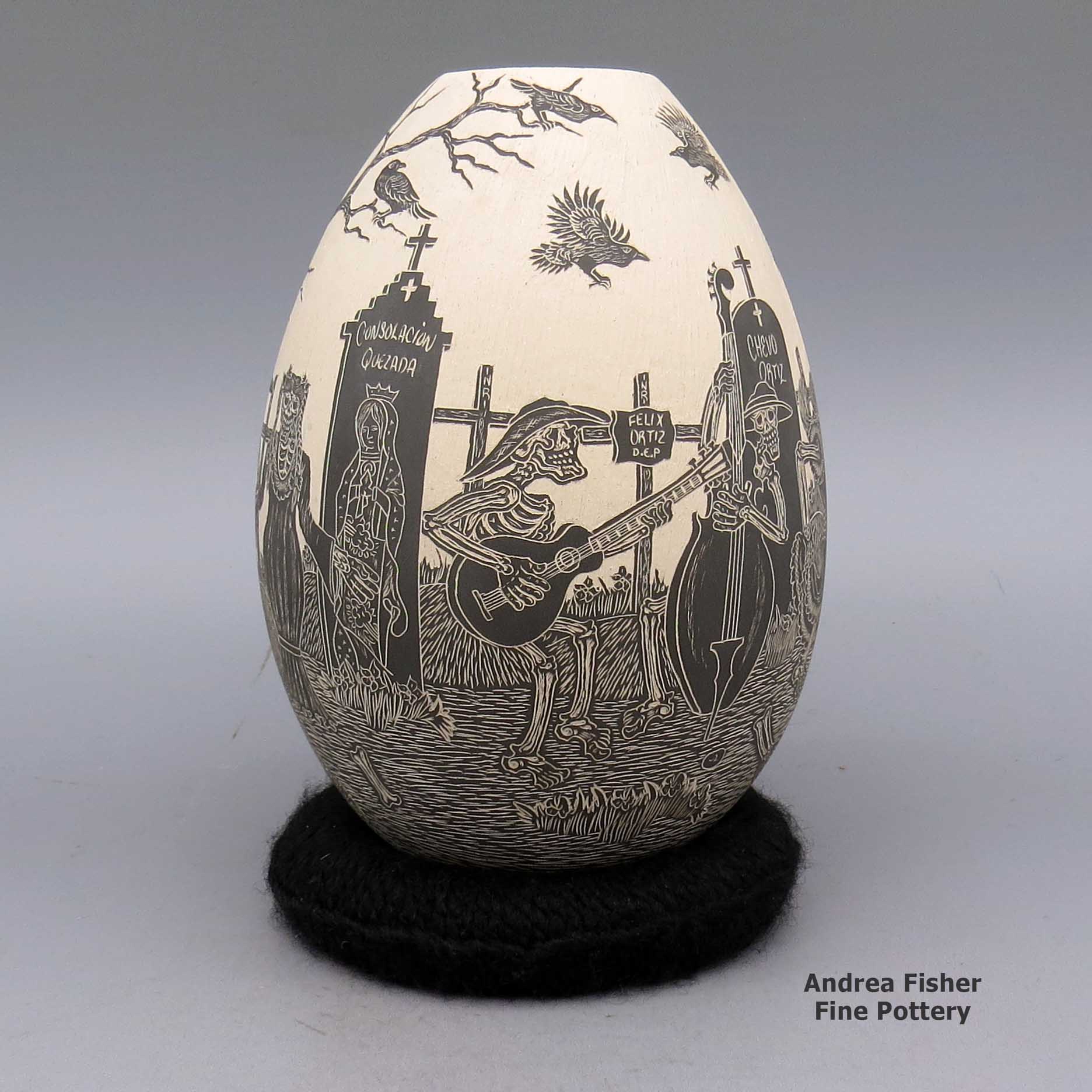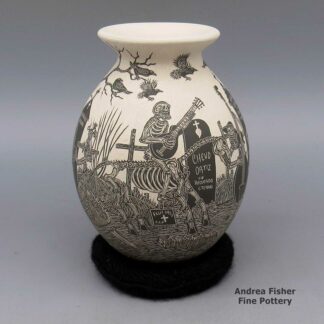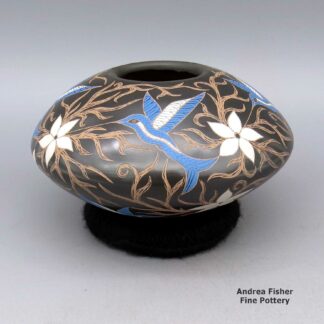| Dimensions | 4 × 4 × 6 in |
|---|---|
| Measurement | Measurement includes stand |
| Condition of Piece | Excellent |
| Signature | H. Javier Martinez Mendez Gabriela Perez de Martinez |
| Date Born | 2022 |
Hector Javier Martinez, zzcg2k280m1: Black-and-white jar with sgraffito Day of the Dead design
$595.00
A black-and-white jar decorated with a sgraffito Day of the Dead motif
In stock
Brand
Martinez, Hector Javier
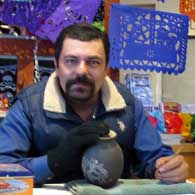 "Time for something different." - The best advice Javier says he ever got, from Steve Rose
"Time for something different." - The best advice Javier says he ever got, from Steve RoseBorn in 1984, Hector Javier Martinez sprang onto the Mata Ortiz pottery scene around 2008 with his distinctive style of black and tan pots incised with Day of the Dead and Night of the Dead motifs. Those designs resulted from a comment made to him by Steve Rose (a well-known American pottery dealer). Employed as an auto mechanic and gardener just to make ends meet while he figured out the pottery making business, Javier had asked what Steve thought he needed to do in order to make pottery his permanent vocation. Steve replied, "Time for something different."
A few years later Javier earned a First Place ribbon in the 2013 Concurso Ceramica Juan Mata Ortiz for one of his Day of the Dead pots. In 2014 he earned the Presidencial Award at the Premio Nacional de la Ceramica in Tlaquepaque, Mexico, for a large olla incised with Mexico City views and his Night of the Dead theme. Since then we have seen his pots with Day of the Dead and Night of the Dead motifs on them with backgrounds from Paris, Santa Fe, Mata Ortiz, Venice, Italy, and New York City.
Javier told us he first learned to make pottery from his mother but her style was very different from what he found in Mata Ortiz. He had to learn all over again, using local materials and different processes and tools.
When he first began decorating his pots his subjects were religious (the Virgin of Guadalupe, priestly images, etc.) and the designs were all painted. It was in 2008 that he and his wife, Gabriela Perez de Martinez produced their first black and white sgraffito Day of the Dead/Night of the Dead pots together. The style took off immediately and they haven't looked back since, although they have branched out a bit and now produce bowls and plates, too.
Today, Javier is producing all kinds and sizes of pots with his signature Day of the Dead and Night of the Dead motifs. However, with his success has come competition and knockoffs. That said, the detail of his work sets him well apart and working with Gabriela has introduced some new elements into their Dia de los Muertos collection of designs.
Javier and Gabriela have four sons now (and Javier says he wants another). He says his inspiration comes from his culture and music. Gabriela concurred with that saying that when he's working on a large pot, he might as well be living as a character on the pot.
In 2020, Hector Javier earned the First Place ribbon for sgraffito design at the annual Concurso Ceramica de Mata Ortiz.
About Mata Ortiz and Casas Grandes
Mata Ortiz is a small settlement inside the bounds of the Casas Grandes municipality, very near the site of Paquimé. The fortunes of the town have gone up and down over the years with a real economic slump happening after the local railroad repair yard was relocated to Nuevo Casas Grandes in the early 1960s. It was a village with a past and little future.
A problem around the ancient sites has been the looting of ancient pottery. From the 1950s on, someone could dig up an old pot, clean it up a bit and sell it to an American dealer (and those were everywhere) for more money than they'd make in a month with a regular job. And there's always been a shortage of regular jobs.
Many of the earliest potters in Mata Ortiz began learning to make pots when it started getting harder to find true ancient pots. So their first experiments turned out crude pottery but with a little work, their pots could be "antiqued" enough to pass muster as being ancient. Over a few years each modern potter got better and better until finally, their work could hardly be distinguished from the truly ancient. Then the Mexican Antiquities Act was passed and terror struck: because the old and the new could not be differentiated, potters were having all their property seized and their families put out of their homes because of "antiqued" pottery they made just yesterday. Things had to change almost overnight and several potters destroyed large amounts of their own inventory because it looked "antique." Then they went about rebooting the process and the product in Mata Ortiz.
For more info:
Mata Ortiz pottery at Wikipedia
Mata Ortiz at Wikipedia
Casas Grandes at Wikipedia
Contemporary Pottery
The term "contemporary" has several possible shadings in reference to Southwestern pottery. At some pueblos, it's more an indicator of a modern style of carving or etching than anything else. At San Felipe it refers to almost anything newly made there as they have almost no prehistoric templates to work from. At Jemez the situation resolved to where what makes a piece uniquely "Jemez" is the clay. Any designs on that clay can be said to be "contemporary."
About Jars
The jar is a basic utilitarian shape, a container generally for cooking food, storing grain or for carrying and storing water. The jar's outer surface is a canvas where potters have been expressing their religious visions and stories for centuries.
In Sinagua pueblos (in northern Arizona), the people made very large jars and buried them up to their openings in the floors of the hidden-most rooms in their pueblo. They kept those jars filled with water but also kept smaller jars of meat and other perishables inside those jars in the water. It's a form of refrigeration still in use among indigenous people around the world.
Where bowls tend to be low, wide and with large openings, jars tend to be more globular: taller, less wide and with smaller openings.
For a potter looking at decorating her piece, bowls are often decorated inside and out while most jars are decorated only on the outside. Jars have a natural continuity to their design surface where bowls have a natural break at the rim, effectively yielding two design surfaces on which separate or complimentary stories can be told.
Before the mid-1800s, storage jars tended to be quite large. Cooking jars and water jars varied in size depending on how many people they were designed to serve. Then came American traders with enameled metal cookware, ceramic dishes and metal eating utensils...Some pueblos embraced those traders immediately while others took several generations to let them and their innovations in. Either way, opening those doors led to the virtual collapse of utilitarian pottery-making in most pueblos by the early 1900s.
In the 1920s there was a marked shift away from the machinations of individual traders and more toward marketing Native American pottery as an artform. Maria Martinez was becoming known through her exhibitions at various major industrial fairs around the country and Nampeyo of Hano was demonstrating her art for the Fred Harvey Company at the Grand Canyon. The first few years of the Santa Fe Indian Market helped to solidify that movement and propel it forward. It took another couple generations of artists to open other venues for their art across the country and turn Native American art into the phenomenon it has become.
Today's jars are artwork, not at all for utilitarian purposes, and their shapes, sizes and decorations have evolved to reflect that shift.
Day/Night of the Dead
The Day of the Dead, El Dia de los Muertos, is a holiday celebrated in Mexico. Ancient rituals from central and southern Mexico, going back more than 2,500 years, are merged with Catholic beliefs brought by the Spanish in the 1500s. The holiday is about honoring the ancestors with food, drink, parties and other activities designed to include the ancestors' spirits in today's daily life. Families also set up ofrendas (private altars) to honor their ancestors.
Death is considered an integral part of the continuum of life and is not to be feared. Celebrations occur November 1 (All Saints Day) when adult spirits come to visit. On November 2 (All Souls Day), families go to the cemetery to decorate the graves of their loved ones. This is a very colorful holiday with marigolds, cardboard skeletons, sugar skulls, incense and tissue paper decorations in riotous colors everywhere.
Depictions of Day of the Dead (and Night of the Dead) activities is a motif explored by several renowned potters from the village of Mata Ortiz in the State of Chihuahua, in northern Mexico. Premier among them is Hector Javier Martinez who originated the style in 2008 after searching for "something different" to help him support his family simply through making and selling his own pottery. Hector has since earned several major awards for his Day of the Dead (and Night of the Dead) pottery. The very prestigious Presidencial Award from the Mexican Concurso Ceramica Nacional in Tlaquepaque is one of them.
Alfredo Rodriguez, Diana Loya, Martin Corona, Adrian Corona and Emiliano Rodriguez are some of the other Mata Ortiz artists using Day of the Dead and Night of the Dead motifs as inspiration for their own creations.

